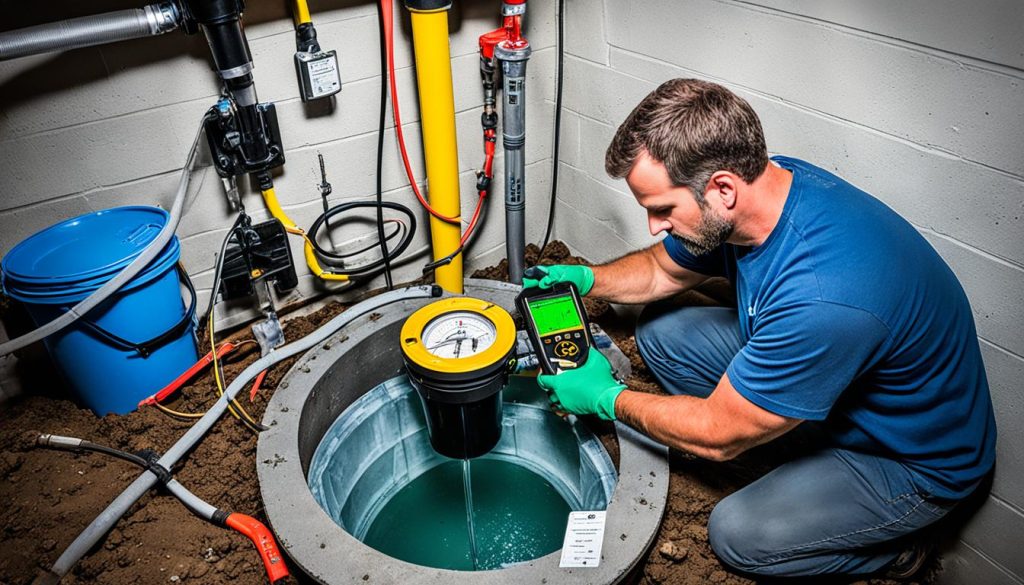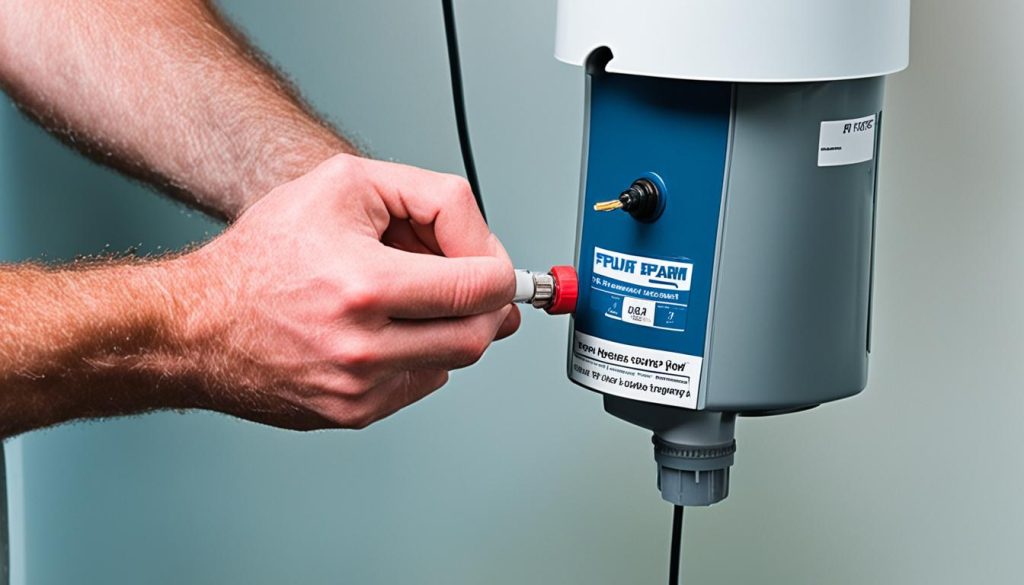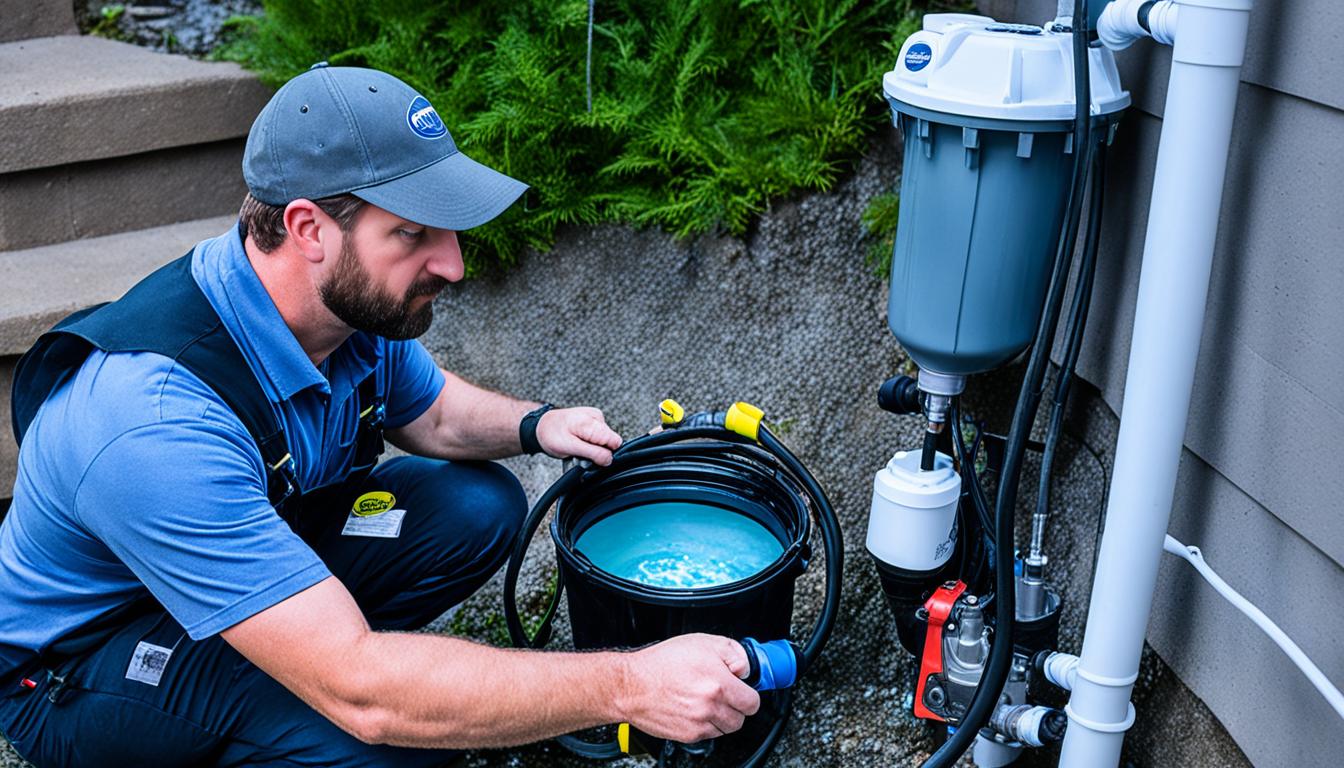Did you know that over 60% of basements in Canada are at risk of experiencing water damage due to inadequate sump pump maintenance? Regularly testing and maintaining your sump pump is crucial in ensuring its functionality and protecting your home from potential flooding.
Key Takeaways:
- Regularly test your sump pump to ensure it is in proper working condition.
- Inspect the exit pipe and remove any clogs or blockages.
- Clean the pump and remove debris that may hinder its operation.
- Depending on the type of sump pump, trace the electrical cords or pour water into the pump pit to test its functionality.
- If any issues or malfunctions are detected, troubleshoot and address them promptly.
Importance of Testing Sump Pump
Testing your sump pump is an essential task to ensure its functionality and reliability, especially during heavy rains and storms. Regularly testing your sump pump allows you to identify any issues or malfunctions and take necessary steps to fix them before a potential flooding event.
By neglecting to test your sump pump, you risk having it fail when you need it the most, leaving your basement vulnerable to water damage. Heavy rains and storms can put a significant strain on your sump pump, and without proper testing, you won’t know if it’s up to the task.
Testing your sump pump gives you peace of mind, knowing that it’s in good working condition and ready to protect your home from potential flooding. It allows you to take proactive measures to address any problems or make any necessary repairs or replacements before it’s too late.
Regular testing also helps you maintain your sump pump’s longevity. By identifying and resolving small issues early on, you can prevent more significant problems from arising, maximizing the lifespan of your sump pump and potentially saving you money on costly repairs or replacements.
Remember, prevention is key when it comes to protecting your home from water damage. Testing your sump pump regularly is a simple yet essential maintenance task to safeguard your property and ensure the well-being of your household.
Sump Pump Testing Procedure
Testing your sump pump is an important part of maintaining its functionality and ensuring that it will effectively protect your home from flooding. By following a simple testing procedure and using a comprehensive inspection checklist, you can ensure that all components of your sump pump are in proper working condition.
Inspection Checklist and Preparation
- Inspect the exit pipe for any clogs or blockages that may hinder the flow of water.
- Remove any debris, such as dirt or leaves, from inside the pump.
- Ensure that the sump pump is properly plugged in and there are no electrical issues.
- Have a bucket or hose ready to pour water into the pump pit.
Testing Methods
There are two common DIY methods to test your sump pump: tracing the electrical cords and pouring water into the pump pit.
Tracing the Electrical Cords:
- Locate the electrical cords connected to the sump pump.
- Trace the cords to the outlet or power source.
- Unplug the sump pump from the power source.
- Plug the sump pump back into the power source.
If the sump pump activates and starts pumping water, it indicates that the electrical connections are functioning correctly. If not, consider checking the power source and electrical connections or consult a professional.
Pouring Water into the Pump Pit:
- Ensure that the sump pump is plugged in and ready to go.
- Fill a bucket or use a hose to pour water into the pump pit.
- Observe the sump pump as it activates and pumps out the water.
If the sump pump turns on and effectively removes the water, it indicates that the pump is working properly. However, if it fails to turn on or struggles to remove the water, there may be an issue with the pump or its components that requires further inspection or professional assistance.
Summary
Regularly testing your sump pump using the sump pump inspection checklist and these DIY methods is crucial for maintaining its functionality and reliability. By identifying any issues early on, you can take necessary steps to address them and ensure that your sump pump is always ready to protect your home from potential flooding.
Troubleshooting Sump Pump Issues
If you find that your sump pump fails the test or displays signs of malfunction, don’t worry, there are troubleshooting steps you can take to address the issue. Follow these steps to troubleshoot common sump pump problems:
1. Check the Intake Pump
Inspect the intake pump for any clogs or obstructions that may be affecting its performance. Remove any debris that you find and ensure that the pump is free from any hindrances.
2. Inspect the Check Valve
Examine the check valve to ensure that it is functioning properly. The check valve prevents water from flowing back into the sump pit after it has been pumped out. Make sure it is not stuck or damaged, as this can impede the effectiveness of your sump pump.
3. Verify Power Issues
Check the power supply to your sump pump to ensure there are no electrical problems. Make sure it is securely plugged in and that there are no tripped circuit breakers or blown fuses. If necessary, test the outlet with another device to confirm it is working.
After performing these troubleshooting steps, test your sump pump again to see if the issue has been resolved. If the problem persists, you may need to clean or replace specific parts of the sump pump or consider replacing the entire unit. Consulting a professional plumber or sump pump specialist may be necessary to address more complex issues.
Regular maintenance and testing of your sump pump can help prevent potential flooding and water damage to your property. By addressing any issues promptly and following the necessary troubleshooting steps, you can ensure that your sump pump functions optimally when you need it the most.
Best Practices for Sump Pump Testing
To ensure accurate testing of a sump pump, there are certain best practices that homeowners should follow. By adhering to these practices, you can enhance the reliability and effectiveness of your sump pump, providing greater peace of mind and protection against potential flooding.
1. Test the Sump Pump Twice a Year
Regular testing is essential to ensure that your sump pump functions properly when you need it most. It is recommended to test your sump pump twice a year, ideally before the spring and fall seasons. This allows you to identify any issues or malfunctions and address them promptly.
2. Test After Prolonged Periods of Disuse
If your sump pump has been idle for an extended period, such as during the winter months or a vacation, it is crucial to test it before relying on it again. This ensures that the pump is in working condition and capable of effectively removing excess water.
3. Have a Backup Power Source
Power outages can occur during severe storms or heavy rains, rendering your primary sump pump useless. To mitigate this risk, it is recommended to have a backup power source, such as a battery-powered backup system. This ensures that your sump pump remains operational even during power disruptions.
4. Regular Maintenance and Inspection
In addition to testing, regular maintenance is vital to keep your sump pump in optimal condition. This includes inspecting the pump for any visible damage, cleaning debris from the pump pit, and ensuring all electrical connections are secure. Regular inspections will help identify any potential issues and allow for prompt repairs or replacements.
5. Monitor the Sump Pump Operation
After testing your sump pump, it is crucial to monitor its operation during heavy rainfall or other weather events that may lead to excess water accumulation. By keeping an eye on the pump’s performance, you can quickly identify any irregularities or signs of malfunction, allowing for timely intervention and maintenance.
6. Keep a Record of Maintenance and Testing
It is advisable to maintain a record of all sump pump maintenance and testing activities. This record will help you track the frequency of testing, identify patterns or recurring issues, and provide documentation for warranty claims and future inspections.
By following these best practices for sump pump testing, you can ensure that your sump pump is in optimal working condition and ready to protect your home against potential flooding.

| Best Practices for Sump Pump Testing |
|---|
| Test the sump pump twice a year |
| Test after prolonged periods of disuse |
| Have a backup power source |
| Regular maintenance and inspection |
| Monitor the sump pump operation |
| Keep a record of maintenance and testing |
Testing Sump Pump Float Switch
The float switch is a crucial component of a sump pump that triggers it to turn on and off based on the water level in the pump pit. Proper testing of the float switch is essential to ensure the efficient operation of the sump pump system.
To test the sump pump float switch, follow these simple steps:
- Locate the float switch inside the sump pump pit.
- Gently lift the float switch to the fully raised position.
- Observe the pump’s response. It should turn on and start pumping water out of the pit.
- Lower the float switch back down to its resting position.
- Observe the pump again. It should turn off once the float switch reaches its resting position.
If the float switch fails to activate the pump or the pump doesn’t turn on and off automatically during the test, it may indicate a problem with the switch or debris obstructing its movement.
Regular testing of the sump pump float switch is crucial to ensure proper functionality and early detection of any issues. If you encounter any problems during the test, it is recommended to consult a professional sump pump technician to diagnose and rectify the problem.
Now that you understand how to test the sump pump float switch, let’s take a look at a table summarizing the testing procedure and possible outcomes:
| Float Switch Test | Results | Action Required |
|---|---|---|
| Float switch activates and pump turns on | Normal | No further action required |
| Float switch fails to activate or pump doesn’t turn on | Abnormal | Consult a sump pump technician for inspection and repair |
| Float switch activates, pump turns on, but doesn’t automatically turn off | Abnormal | Consult a sump pump technician for inspection and repair |

Testing the float switch is an essential part of maintaining a reliable sump pump system. By regularly testing and ensuring the proper functioning of all components, you can have peace of mind knowing that your sump pump will effectively protect your home from potential water damage.
When to Test Sump Pump
Testing your sump pump regularly is crucial to ensure it is functioning properly and can effectively protect your home from potential flooding. It is recommended to test your sump pump twice a year, before the spring and fall seasons. By doing so, you can address any issues or malfunctions before they become a problem.
In addition to the routine testing, it is important to consider testing your sump pump after any extreme weather events or heavy rainfalls. These situations can put your sump pump to the test, and checking its functionality afterward ensures it is still in good working condition.
Regular testing and maintenance are key to keeping your sump pump in optimal shape. By testing it at the recommended intervals and after significant weather events, you can have peace of mind knowing that your sump pump is ready to protect your home from potential flooding.
